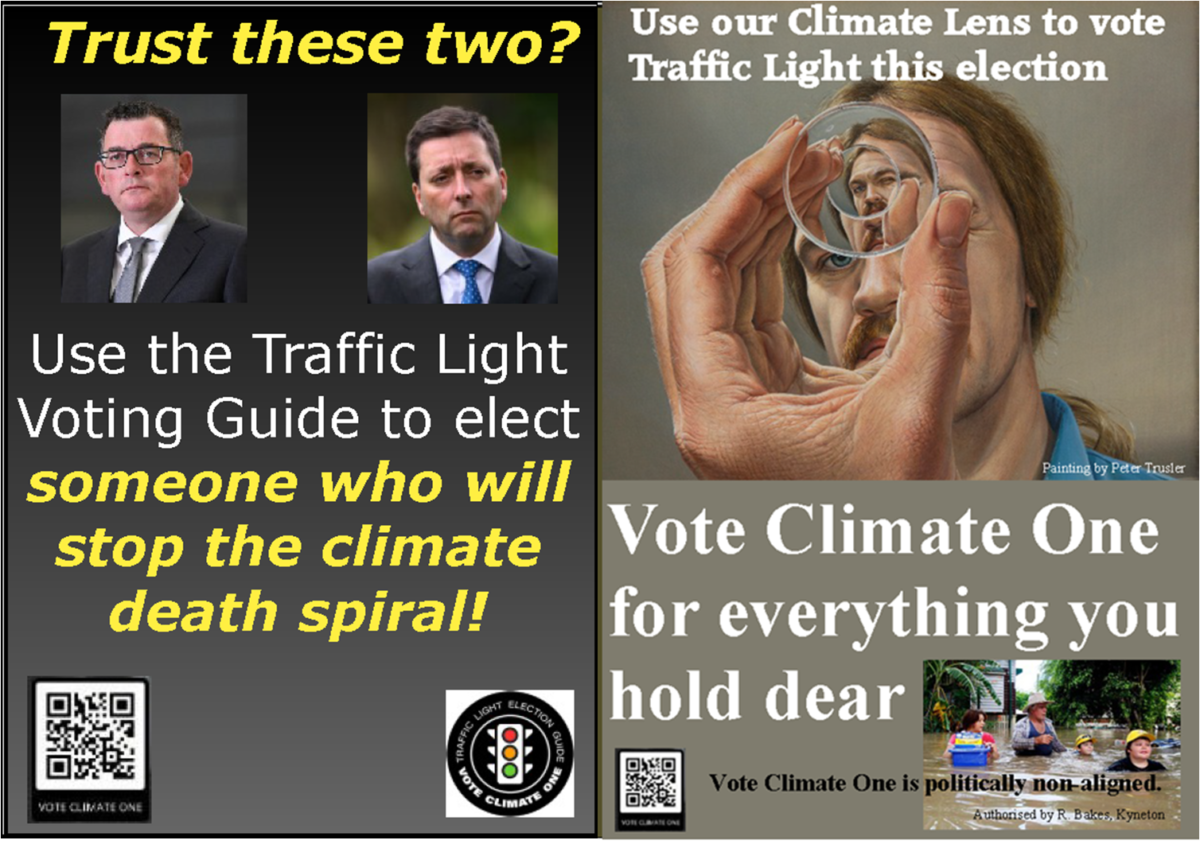SIRNINGER RANKIN, Nadia
All candidates from the Australian Greens have been allocated a green light after our rigorous assessment process. The party advocates for an immediate freeze on all new coal, oil and gas projects. They have a comprehensive and fully-costed climate plan which aims for a 100% transition to renewable energy. The plan takes into consideration the economic and social impact of climate change and the measures required to prevent further global warming

CLIMATE CHANGE AND ENERGY
The climate crisis is negatively impacting all aspects of modern life, contributing to disruption of ecosystems, biodiversity and human societies through sea level rise, extreme weather events, desertification and changing weather patterns, and threatening food security, water, the economy, social cohesion and the well-being of humans and other living things. These impacts will escalate in the future.
The climate crisis requires us to seize the opportunity to transform Australia into a greenhouse gas-negative powerhouse that creates new jobs and a cleaner planet.
PRINCIPLES
The Australian Greens believe that:
1. The impacts of the human-induced climate crisis pose an existential threat to ecosystems, biodiversity and human societies.
2.It is the duty of every government and organisation to take substantive action to solve the climate crisis.
3. Urgent, equitable and sustained local, national and global action is required to avoid climate catastrophe.
4. A safer climate will require a return to an atmospheric concentration of greenhouse gases equivalent to 350 parts per million of CO2, or lower.
5. Australia’s climate policy must be consistent with our commitment under the Paris Agreement to pursue efforts to limit the temperature increase to 1.5°C above pre-industrial levels.
6. As Australia has emitted and continues to emit a disproportionate amount of greenhouse gases, we have a greater responsibility to resettle and rehouse people and populations displaced by the climate crisis.
7. Australia needs urgently to phase out fossil fuels for export and domestic use.
8. A just transition for communities and workers affected by closure of fossil fuel based mining and electricity generation industries is essential.
9. Australia is a wealthy nation with extensive renewable energy resources that should be used to benefit all Australians; it has both the opportunity and the responsibility to become a world leader in addressing the climate crisis.
10. Australia’s exports and domestic per capita pollution make it one of the largest contributors to the climate crisis. Australia must urgently reduce domestic greenhouse gas emissions to net negative. We must actively support international efforts to remove global emissions from the environment and plan to adapt to the impacts of the climate crisis which are now inevitable.
11. Many of the harshest impacts of the climate crisis disproportionately affect those already experiencing disadvantage. Solving the climate crisis and building a just society go hand in hand.
12. Climate action must include and respond to the specific experiences, knowledge, priorities and needs of First Nations Peoples.
13. Equity must be at the core of all climate change negotiations and measures while transitioning to an economy and society that supports a safer climate.
14. The climate crisis necessitates a transition away from an economy reliant on unsustainable consumption and production to one that has net zero greenhouse gas emissions. Any cost of creating an economy that adapts to climate change and supports a safer climate must be distributed fairly, both domestically and internationally.
15. In moving to a net negative greenhouse gas economy, it is essential to minimise the adverse impacts of that transition on communities that are most at risk and most disadvantaged.
16. Failing to transition to a net negative greenhouse gas future will have adverse impacts on people and society through:
1. mass death and suffering;
2. increasing and intensified extreme weather events and related environmental disasters;
3. increased risks to water resources, agriculture and food security;
4. the increased cost of adaptation and
5. lost or diminished economic opportunities by delaying the transition to renewables.
17. Australia has the capacity to ensure that all of our energy needs can be provided by renewable sources
18. A nationwide, systematic response is required to drastically reduce emissions from all sectors, draw down greenhouse gases, and be greenhouse gas neutral or negative by 2035.
19. Significant reductions in greenhouse gas emissions can be achieved by reducing waste and unnecessary production and consumption.
20. Energy prices should reflect the environmental, social, health and other external costs of its production and use.
21. The refurbishment of existing coal fired power stations, except for transitions to renewable energy, undermines the effort to increase end-use energy efficiency, demand management and renewable energy.
22. Australia has a responsibility to assist other nations, particularly in the Asia-Pacific, to create safer climate economies and adapt to the climate crisis.
23. All energy infrastructure must be regulated by government, and large scale energy infrastructure and networks should be in public or community ownership.
AIMS
The Australian Greens want:
1. Net zero or net negative Australian greenhouse gas emissions by 2035 or sooner.
2. A leading role for Australia in international negotiations leading to a multilateral emission abatement treaty. This treaty would share the opportunities and responsibilities equitably, recognising the proportionately greater historical and current contribution of wealthy industrialised nations to the climate crisis.
3. To build support in the community for urgent action to achieve a safe climate.
4. Australia to use its scientific, diplomatic and economic influence to promote the development and deployment of non-polluting alternatives to fossil fuel based energy.
5. Removal of all subsidies to the fossil fuel industry.
6. An orderly phase out of the exploration for, extraction, consumption and export of fossil fuels consistent with our emissions reduction plan.
7. A just transition to a net negative greenhouse gas economy through a range of mechanisms including a plan to replace fossil fuels with renewable energy through strong regulatory intervention and a strong effective price on carbon.
8. Subsidies to the fossil fuel sector to be removed, and investment in relevant climate change mitigation sectors should be increased.
9. A well-funded, comprehensive and research-based emissions reduction plan, with binding annual targets and national emissions limits, supported by reporting for all sectors with significant greenhouse emissions.
10. Reduce the overproduction and overconsumption of consumer goods that both depend upon fossil fuels and put unnecessary pressure on environmental resources.
11. A legislative framework that addresses the climate crisis as a priority responsibility of the federal government, and ensures that:
i. all relevant legislation and regulations, from all levels of government, require that the climate crisis be considered;
ii. justice, equality and democracy remain the guiding principles in government responses to the climate crisis;
iii. the climate crisis is at the forefront of decisions made by governing and regulatory bodies for energy markets;
iv. the climate crisis is central in all decision and approval processes involving all levels of government, and involving matters of national environmental significance as currently set out under the Environment Protection and Biodiversity Conservation Act 1999 (EPBC Act) and;
v. all decisions and their rationale made by all levels of government that may have implications for the climate crisis are publicly reported.
12. A national system of energy efficiency targets and stringent Minimum Energy Performance Standards that are consistent with, or exceed, world’s best practice for products, buildings and infrastructure.
13. Support for state and local government initiatives to encourage the reuse and recycling of building materials.
14. A government-supported shift to 100% renewables.
15. Construction of a comprehensive system of storage and transmission to achieve 100% renewable energy.
16. 100% of electricity used in Australia to come from renewable sources as soon as possible, by increasing the renewable energy target (RET) as well as measures such as public investment, feed-in tariffs and regulations to support a range of renewable energy generation, storage, transmission networks, efficiency, and export technologies.
17. The pricing of electricity and fossil fuels to reflect their true cost, including externalities such as their impacts on health, water resources, ecosystems, agricultural production, air pollution and climate crisis.
18. Exclusion of new in-stream utility-scale hydroelectric power stations and all electricity from burning native forests from the RET.
19. Reform of energy markets to remove the bias toward centralised fossil fuel-based generation, encourage demand management and the development of distributed generation, storage and transmission of renewable energy.
20. Improved regulations, monitoring and compliance for all existing gas operations, particularly in relation to methane emissions, impact on water resources, agricultural land and biodiversity.
21. Rapid rollout of smart technology, including meters, appliances, grids and energy storage, with measures to reduce the financial impact on people with low or fixed incomes.
22. To build capacity within our communities and industries to develop and expand local renewable energy, including through increasing community and public ownership of energy production and storage.
23. No new coal-fired power stations, gas mines or oil wells, and no expansions to any existing coal- or gas-fired power stations or mines, plus the development of programs to assist fossil fuel-dependent communities to make the transition to other more sustainable sources of economic prosperity.
24. Coal fired power stations should be decommissioned.
25. Thermal coal exports to be phased out by 2030 and all other fossil fuel exports to cease by 2040, with the exception of metallurgical coal.
26. The adoption of the precautionary principle in relation to capturing carbon through geosequestration, by opposing public funding, and ensuring that companies are financially responsible for the risks and effects of greenhouse gas leakage.
27. Preservation and promotion of natural carbon sequestration in soils, forests and marine sea grass and kelp, swamps and mangrove beds, and a funding and focus on restoring these natural carbon sinks.
28. To use the Government’s vehicle fleet procurement policies to contribute to the elimination of greenhouse gas emissions, including through the use of zero emission vehicles.
29. Research, development and deployment of sustainable fuels which demonstrably reduce greenhouse gas emissions, and do not threaten biodiversity or food security.
30. Research, development and deployment of greenhouse gas neutral technologies for manufacturing and industry, particularly replacing the direct use of fossil fuels in industrial processes.
31. Research, development and deployment of mechanisms to significantly reduce greenhouse gas emissions from sea and air transport and ensure that greenhouse gas emissions from sea and air transport, both domestically and internationally, are calculated, reported and accounted for under national and international obligations.
32. Research, development and the implementation of sustainable agricultural methods that reduce greenhouse gas emissions, while transitioning from industrial farming practices that are greenhouse gas intensive or rely on fossil fuels.
33. Research, development and deployment of processes that will allow Australian industry to convert renewable energy into an exportable resource.
34. The creation of a renewable energy export industry, including renewables-generated fuels such as Green Hydrogen, direct connections to neighbouring countries and the export of technology.
35. The implementation of world leading vehicle fuel efficiency and emissions standards while transitioning to sustainable transport.
36. The development and expansion of robust distribution networks for sustainable alternative fuels and charging facilities for electric vehicles.
37. Corporations exporting fossil fuels to be required to include in their annual reports the quantities of greenhouse gases embodied in their exports, whether or not liability for those emissions is covered by the laws of the recipient country.
38. An Australian government investment policy that divests from all fossil fuel extraction and consumption.
39. A requirement that all large companies, resources companies, and the financial sector report their exposure to global warming risk using uniform standards developed by the Council of Financial Regulators.
40. The development of a mechanism to ensure that the embedded emissions in imported goods are calculated and reported, noting that Australia and other developed countries effectively export their emissions liability by importing goods rather than manufacturing them.
41. Engagement with the international community to ensure that international reporting of emissions includes imported emissions (not only emissions emanating from activities undertaken in each country), thereby providing a more accurate estimation of each country’s ecological footprint.
42. Stronger environmental laws and systems that prohibit further land clearing or logging native forests, or activities that reduce carbon storage or pose a threat to kelp forests and seagrass beds in order to protect natural carbon drawdown mechanisms.
43. Improved planning and adaptation mechanisms for coastal communities that will be affected by rising sea levels.
44. Improved climate adaptation planning for agricultural areas that will be impacted by climate variability, desertification, drought, extreme weather events and fires.
45. To promote agricultural, forestry and land use regimes in which photosynthetic sequestration of carbon dioxide exceeds its emission to the atmosphere.
46. The creation of a renewables export industry, including renewables-generated liquid fuels, direct connections to neighbouring countries and the export of technology.
(Climate Change and Energy policy as amended by Special National Conference August 2020.)






